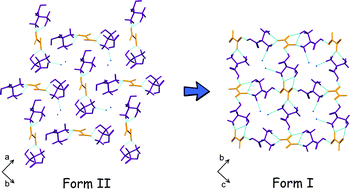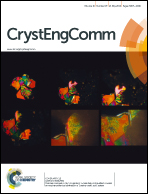The role of a liquid in “dry” co-grinding: a case study of the effect of water on mechanochemical synthesis in a “l-serine–oxalic acid” system†
Abstract
The results of the synthesis in the “L-serine–oxalic acid–water” system were compared for co-grinding of powder samples with water added in four different ways: as crystal water to either or both of the reactants or as a drop of water in the liquid phase. The products formed on co-grinding were compared with each other and with those that crystallised from solutions on slow evaporation under ambient conditions, on spray drying and on antisolvent crystallisation. Co-grinding of dry anhydrous reagents gave only trace amounts of the product phase (anhydrous 1 : 1 serinium oxalate) apparently due to the interaction with trace amounts of water in the air. In the presence of crystal water or water added in the liquid phase, the polymorphs of [L-serH]2[ox]·2H2O (as pure forms or in a mixture) were formed. Neat co-grinding of anhydrous oxalic acid with L-serine monohydrate or of anhydrous L-serine with oxalic acid dihydrate gave polymorph II (kinetic form). Co-grinding of L-serine monohydrate with oxalic acid dihydrate as well as liquid-assisted grinding with a sufficient amount of liquid water added gave polymorph I (thermodynamic form) and polymorph 2 (with a very low transformation degree) if too little water was added. The seemingly solid-state reaction proceeded in fact in the liquid phase at a contact between the solid particles and did not depend on the crystal structures of the initial components. The role of mechanical treatment in inducing the synthesis is merely bringing the reacting species into contact, improving their mixing, and facilitating the dehydration of crystal hydrates. The reaction could be observed also on storage of mixtures, via the intermediate aqueous solution formed at the contacts between particles, resulting in the same intermediate product as obtained by spray drying, whereas antisolvent crystallisation and slow evaporation gave the same polymorph as was eventually observed on LAG or on prolonged storage of a solid mixture.

- This article is part of the themed collection: Editor’s Collection: Mechanochemistry

 Please wait while we load your content...
Please wait while we load your content...